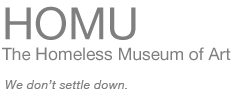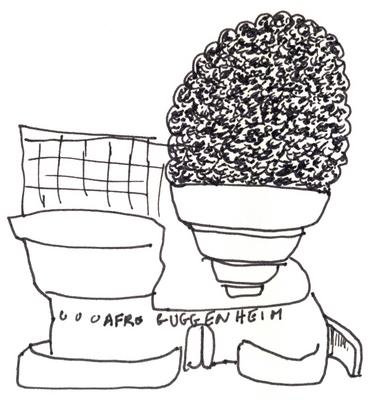Of Chicken Wings and Hair Pieces
Noterdaeme and Isengart discuss the Homeless Museum's take on contemporary museum architecture.
Recorded in Brooklyn, November 2006
Daniel Isengart: In "There's No Place Like HoMu," you announced that your most ambitious project to date, the New Homeless Museum (NHoMu), was going to be realized in Kansas City in the summer of 2007. A couple of months ago, the project got cancelled. What happened?
Filip Noterdaeme: My closest collaborator on the project, a young architect whom I had invited on board to assist me, attempted to challenge my position as the project's author. This greatly damaged our professional relationship and sabotaged the project's development phase, of which he was in charge. When I couldn't meet my sponsor's deadline for submitting a master plan, the project fell apart.
DI: You had high hopes for NHoMu. How did you deal with this blow?
FN: After a grieving period, I realized I had to take part of the blame. NHoMu was a bold statement against the hype that surrounds contemporary museum architecture and the star architects who design them. It should have occurred to me that bringing a young, ambitious architect on board was calling for trouble. The project got to his head.
DI: Okay, so NHoMu will not be built in Kansas City in 2007. Does that mean that it will never be realized?
FN: The NHoMu I conceived in 2004 will not be built, but I am keeping its core idea alive and may revive it under different circumstances.
DI: You have another, more recent concept for a large-scale, public art project up your sleeve: The Newest.
FN: The first museum with a velvet rope policy! I built an architectural model for it, complete with a robotics system and remote control. It's on display here at HoMu BKLYN and a big hit with kids and tech nerds.
DI: Describe it for us.
FN: The Newest is a project that essentially mocks contemporary art museums' emphasis on image and spin. Why not omit the art altogether? All you need is a building fašade, equipped with LED screens, and a savvy PR team. You could install moving mannequins behind the windows to perfect the illusion of a building that's continuously bustling with visitors. Then, you create a lot of hype and, to make the museum even more notorious, you never let anybody inside, except for people who are in on the joke.
DI: Put me on the guest list! Let's talk about the first architectural extension we added to HoMu BKLYN in October: The Chicken Wing.
FN: And to be clear, it is exactly what it says: a real chicken wing. Colored orange, thoroughly cooked, and speared onto a wire hanger, which I affixed to the exterior wall of our building, right under our bedroom window. In the press release, I announced that it had been created by Intelligent Design Team Pollo and Poulet. We had a pompous red carpet and ribbon-cutting ceremony for the opening. At some point, the new Wing was almost snatched away by a hungry squirrel, but we were able to shoo away the intruder.
DI: Imagine the headline had it happened: Homeless Museum's New Wing Destroyed by Natural Disaster!
FN: Looking at other museums and their costly expansions, I wonder: do they just have too much money, or are they simply desperate? It's all done in the name of art, but to me it looks more like a big showcase for cutting-edge architecture. I am proud to say that my museum's extension was extremely low-cost, while quite effective and high-flying - no pun intended.
DI: What do you think museums should do to stay in the public eye?
FN: Instead of hiring star architects, they should start working with hair stylists. Hairpieces and extensions are all the rage right now. I am convinced that MoMA would look great with a weave, and I can very well imagine the Guggenheim with an Afro.
DI: What about the Met?
FN: An understated toupee. No need to overdo it.

